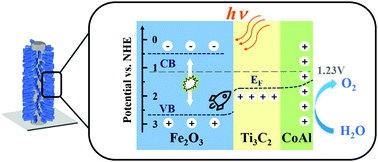Ultrathin Ti3C2 nanosheets served as a highly efficient hole transport layer on a Fe2O3 photoanode for photoelectrochemical water oxidation†
Abstract
Surface modification of oxygen evolution reaction (OER) cocatalysts is a promising approach to improve PEC water oxidation activity by accelerating the surface charge injection efficiency and catalytic reaction kinetics. However, the PEC performance is still restricted by inefficient charge transfer at the semiconductor/cocatalyst interface. In this study, ultrathin Ti3C2 nanosheets, serving as a highly efficient hole transport layer, were introduced into the Fe2O3/CoAl-layered double hydroxide (LDH) interface. The obtained Fe2O3–Ti3C2–CoAl photoanodes exhibited a significantly improved photocurrent density of 2.1 mA cm−2 at 1.23 V versus the reversible hydrogen electrode (RHE) under AM 1.5G illumination. In this system, the Ti3C2 nanolayer not only suppresses the interfacial recombination of photogenerated carriers but also facilitates efficient hole transfer from Fe2O3 to the OER cocatalyst, thus promoting the PEC performance. This study provides a new guideline for optimizing the charge transfer at the semiconductor/cocatalyst interface.



 Please wait while we load your content...
Please wait while we load your content...